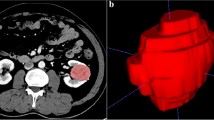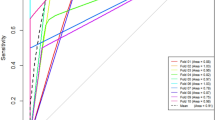Abstract
Purpose
This study aims to assess the computed tomography (CT) findings of renal epithelioid angiomyolipoma (EAML) and develop a radiomics-based model for differentiating EAMLs and clear cell renal cell carcinomas (RCCs).
Method
This two-center retrospective study included 28 histologically confirmed EAMLs and 56 size-matched clear cell RCCs with preoperative three-phase kidney CTs. We conducted subjective image analysis to determine the CT parameters that can distinguish EAMLs from clear cell RCCs. Training and test sets were divided by chronological order of CT scans, and radiomics model was built using ten selected features among radiomics and CT features. The diagnostic performance of the radiomics model was compared with that of the three radiologists using the area under the receiver-operating characteristic curve (AUC).
Results
The mean size of the EAMLs was 6.2 ± 5.0 cm. On multivariate analysis, a snowman or ice cream cone tumor shape (OR 16.3; 95% CI 1.7–156.9, P = 0.02) and lower tumor-to-cortex (TOC) enhancement ratio in the corticomedullary phase (OR 33.4; 95% CI 5.7–197, P < 0.001) were significant independent factors for identifying EAMLs. The diagnostic performance of the radiomics model (AUC 0.89) was similar to those of genitourinary radiologists (AUC 0.78 and 0.81, P > 0.05) and superior to that of a third-year resident (AUC 0.63, P = 0.04).
Conclusions
A snowman or ice cream cone shape and lower TOC ratio were more closely associated with EAMLs than with clear cell RCCs. A CT radiomics model was useful for differentiating EAMLs from clear cell RCCs with better diagnostic performance than an inexperienced radiologist.






Similar content being viewed by others
Abbreviations
- CT:
-
Computed tomography
- EAML:
-
Epithelioid angiomyolipoma
- GLRLM:
-
Gray-level run length matrices
- GLSZM:
-
Gray-level size zone matrices
- HU:
-
Hounsfield units
- ICC:
-
Intra-class correlation coefficient
- RCC:
-
Renal cell carcinomas
- ROC:
-
Receiver-operating characteristic curve
- ROI:
-
Regions of interest
- TOC:
-
Tumor-to-cortex
- WHO:
-
World Health Organization
References
Park BK (2017) Renal Angiomyolipoma: Radiologic Classification and Imaging Features According to the Amount of Fat. Am J Roentgenol 209:826–835. https://doi.org/10.2214/AJR.17.17973
Thiravit S, Teerasamit W, Thiravit P (2018) The different faces of renal angiomyolipomas on radiologic imaging: a pictorial review. Br J Radiol 20170533. https://doi.org/10.1259/bjr.20170533
Moch H, Cubilla AL, Humphrey PA, et al (2016) The 2016 WHO Classification of Tumours of the Urinary System and Male Genital Organs—Part A: Renal, Penile, and Testicular Tumours. Eur Urol 70:93–105. https://doi.org/10.1016/j.eururo.2016.02.029
Faraji H, Nguyen BN, Mai KT (2009) Renal epithelioid angiomyolipoma: a study of six cases and a meta-analytic study. Development of criteria for screening the entity with prognostic significance. Histopathology 55:525–534. https://doi.org/10.1111/j.1365-2559.2009.03420.x
Bharwani N, Christmas TJ, Jameson C, et al (2009) Epithelioid angiomyolipoma: imaging appearances. Br J Radiol 82:e249–e252. https://doi.org/10.1259/bjr/27259024
Cong X, Zhang J, Xu X, et al (2018) Renal epithelioid angiomyolipoma: magnetic resonance imaging characteristics. Abdom Radiol 43:2756–2763. https://doi.org/10.1007/s00261-018-1548-6
Cui L, Zhang J-G, Hu X-Y, et al (2012) CT imaging and histopathological features of renal epithelioid angiomyolipomas. Clin Radiol 67:e77–e82. https://doi.org/10.1016/j.crad.2012.08.006
Froemming AT, Boland J, Cheville J, et al (2013) Renal Epithelioid Angiomyolipoma: Imaging Characteristics in Nine Cases With Radiologic-Pathologic Correlation and Review of the Literature. Am J Roentgenol 200:W178–W186. https://doi.org/10.2214/AJR.12.8776
Tsukada J, Jinzaki M, Yao M, et al (2013) Epithelioid angiomyolipoma of the kidney: Radiological imaging: Imaging of epithelioid angiomyolipoma. Int J Urol 20:1105–1111. https://doi.org/10.1111/iju.12117
Lei JH, Liu LR, Wei Q, et al (2015) A Four-Year Follow-up Study of Renal Epithelioid Angiomyolipoma: A Multi-Center Experience and Literature Review. Sci Rep 5:10030. https://doi.org/10.1038/srep10030
Gillies RJ, Kinahan PE, Hricak H (2016) Radiomics: Images Are More than Pictures, They Are Data. Radiology 278:563–577. https://doi.org/10.1148/radiol.2015151169
Suarez-Ibarrola R, Basulto-Martinez M, Heinze A, et al (2020) Radiomics Applications in Renal Tumor Assessment: A Comprehensive Review of the Literature. Cancers 12:1387. https://doi.org/10.3390/cancers12061387
Sun X-Y, Feng Q-X, Xu X, et al (2020) Radiologic-Radiomic Machine Learning Models for Differentiation of Benign and Malignant Solid Renal Masses: Comparison With Expert-Level Radiologists. AJR Am J Roentgenol 214:W44–W54. https://doi.org/10.2214/AJR.19.21617
Feng Z, Rong P, Cao P, et al (2018) Machine learning-based quantitative texture analysis of CT images of small renal masses: Differentiation of angiomyolipoma without visible fat from renal cell carcinoma. Eur Radiol 28:1625–1633. https://doi.org/10.1007/s00330-017-5118-z
Ma Y, Ma W, Xu X, et al (2021) A convention-radiomics CT nomogram for differentiating fat-poor angiomyolipoma from clear cell renal cell carcinoma. Sci Rep 11:4644. https://doi.org/10.1038/s41598-021-84244-3
Young JR, Margolis D, Sauk S, et al (2013) Clear Cell Renal Cell Carcinoma: Discrimination from Other Renal Cell Carcinoma Subtypes and Oncocytoma at Multiphasic Multidetector CT. Radiology 267:444–453. https://doi.org/10.1148/radiol.13112617
Tsai C-C, Wu W-J, Li C-C, et al (2009) Epithelioid Angiomyolipoma of the Kidney Mimicking Renal Cell Carcinoma: A Clinicopathologic Analysis of Cases and Literature Review. Kaohsiung J Med Sci 25:133–140. https://doi.org/10.1016/S1607-551X(09)70052-X
Kim KH, Yun BH, Jung SI, et al (2013) Usefulness of the Ice-Cream Cone Pattern in Computed Tomography for Prediction of Angiomyolipoma in Patients With a Small Renal Mass. Korean J Urol 54:504–509. https://doi.org/10.4111/kju.2013.54.8.504
Israel GM, Bosniak MA (2008) Pitfalls in Renal Mass Evaluation and How to Avoid Them. RadioGraphics 28:1325–1338. https://doi.org/10.1148/rg.285075744
Chen X, Huang Y, He L, et al (2020) CT-Based Radiomics to Differentiate Pelvic Rhabdomyosarcoma From Yolk Sac Tumors in Children. Front Oncol 10:
Yu L, Liu H (2004) Efficient Feature Selection via Analysis of Relevance and Redundancy. J Mach Learn Res 5:1205–1224
Viera AJ, Garrett JM Understanding Interobserver Agreement: The Kappa Statistic. Fam Med 4
Cheville JC, Lohse CM, Zincke H, et al (2003) Comparisons of Outcome and Prognostic Features Among Histologic Subtypes of Renal Cell Carcinoma. Am J Surg Pathol 27:612–624
Brimo F, Robinson B, Guo C, et al (2010) Renal Epithelioid Angiomyolipoma With Atypia: A Series of 40 Cases With Emphasis on Clinicopathologic Prognostic Indicators of Malignancy. Am J Surg Pathol 34:715–722. https://doi.org/10.1097/PAS.0b013e3181d90370
Espinosa M, Roldán-Romero JM, Duran I, et al (2018) Advanced sporadic renal epithelioid angiomyolipoma: case report of an extraordinary response to sirolimus linked to TSC2 mutation. BMC Cancer 18:561. https://doi.org/10.1186/s12885-018-4467-6
Kohno J, Matsui Y, Yamasaki T, et al (2013) Role of mammalian target of rapamycin inhibitor in the treatment of metastatic epithelioid angiomyolipoma: A case report. Int J Urol 20:938–941. https://doi.org/10.1111/iju.12095
Saoud R, Kristof TW, Judge C, et al (2022) Clinical and pathological features of renal epithelioid angiomyolipoma (PEComa): A single institution series. Urol Oncol Semin Orig Investig 40:18–24. https://doi.org/10.1016/j.urolonc.2021.09.010
Escudier B, Porta C, Schmidinger M, et al (2019) Renal cell carcinoma: ESMO Clinical Practice Guidelines for diagnosis, treatment and follow-up. Ann Oncol 30:706–720. https://doi.org/10.1093/annonc/mdz056
Verma SK, Mitchell DG, Yang R, et al (2010) Exophytic Renal Masses: Angular Interface with Renal Parenchyma for Distinguishing Benign from Malignant Lesions at MR Imaging. Radiology 255:501–507. https://doi.org/10.1148/radiol.09091109
Jinzaki M, Silverman SG, Akita H, et al (2017) Diagnosis of Renal Angiomyolipomas: Classic, Fat-Poor, and Epithelioid Types. Semin Ultrasound CT MRI 38:37–46. https://doi.org/10.1053/j.sult.2016.11.001
Jinzaki M, Tanimoto A, Mukai M, et al (2000) Double-Phase Helical CT of Small Renal Parenchymal Neoplasms: Correlation with Pathologic Findings and Tumor Angiogenesis. J Comput Assist Tomogr 24:835–842
Luo C, Liu Z, Gao M, et al (2021) Renal epithelioid angiomyolipoma: computed tomography manifestation and radiologic–pathologic correlation depending on different epithelioid component percentages. Abdom Radiol. https://doi.org/10.1007/s00261-021-03313-3
He W, Cheville JC, Sadow PM, et al (2013) Epithelioid angiomyolipoma of the kidney pathological features and clinical outcome in a series of consecutively resected tumors. Mod Pathol Off JUS Can Acad Pathol Inc 26:1355–1364. https://doi.org/10.1038/modpathol.2013.72
Lam JS, Klatte T, Patard J-J, et al (2007) Prognostic Relevance of Tumour Size in T3a Renal Cell Carcinoma: A Multicentre Experience. Eur Urol 52:155–162. https://doi.org/10.1016/j.eururo.2007.01.106
Berenguer R, Pastor-Juan M del R, Canales-Vázquez J, et al (2018) Radiomics of CT Features May Be Nonreproducible and Redundant: Influence of CT Acquisition Parameters. Radiology 288:407–415. https://doi.org/10.1148/radiol.2018172361
Shafiq-ul-Hassan M, Zhang GG, Latifi K, et al (2017) Intrinsic dependencies of CT radiomic features on voxel size and number of gray levels. Med Phys 44:1050–1062. https://doi.org/10.1002/mp.12123
Acknowledgements
We appreciate to SeongYong Pak (Siemens Healthineers, Seoul, Korea) for technical support in this study.
Funding
The authors did not receive support from any organization for the submitted work.
Author information
Authors and Affiliations
Contributions
TMK Conceptualization, Methodology, Software, Formal analysis, Data Curation, Writing – Original Draft, Writing – Review & Editing, HA Methodology, Software, Formal analysis, Data Curation, Writing – Original Draft, Writing – Review & Editing, HJL Formal analysis, Data curation, Writing – Review & Editing, MGK Formal analysis, Data curation, Writing – Review & Editing, JYC Supervision, Writing – Review & Editing, SIH Supervision, Writing – Review & Editing, SYK Conceptualization, Methodology, Formal analysis, Data Curation, Writing – Review & Editing.
Corresponding author
Ethics declarations
Conflict of interest
The authors have no competing interests to declare that are relevant to the content of this article.
Ethical approval
This retrospective study was approved by the institutional review board in our center, and the requirement for written informed consent was waived.
Additional information
Publisher's Note
Springer Nature remains neutral with regard to jurisdictional claims in published maps and institutional affiliations.
Supplementary Information
Below is the link to the electronic supplementary material.
Rights and permissions
About this article
Cite this article
Kim, T.M., Ahn, H., Lee, H.J. et al. Differentiating renal epithelioid angiomyolipoma from clear cell carcinoma: using a radiomics model combined with CT imaging characteristics. Abdom Radiol 47, 2867–2880 (2022). https://doi.org/10.1007/s00261-022-03571-9
Received:
Revised:
Accepted:
Published:
Issue Date:
DOI: https://doi.org/10.1007/s00261-022-03571-9




